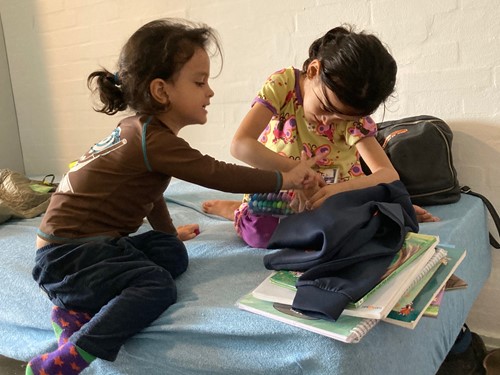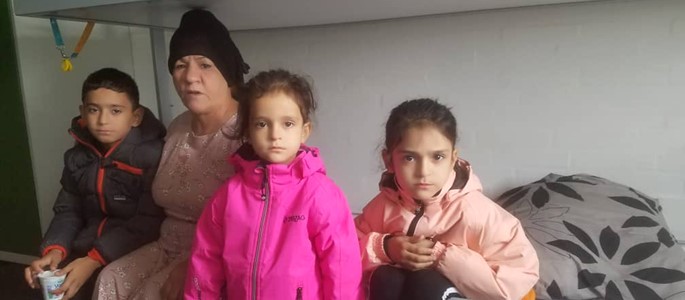Information for and about the evacuated Afghans in Denmark
What happens with the Special Law and the 850 Afghans who were evacuated and are now waiting in the asylum centres? We bring important information and good advice
Dwnload our GOOD ADVICE for the Afghans in Danish, English and Dari:
JPG-format
Factual information in this article comes directly from Immigration Service.
The article will be updated with latest news, last update 19. November.
The evacuation
Between the 19th and the 27th August 2021, 1,000 Afghans were evacuated from Kabul to Denmark. It happened on the basis of a political agreement about former military interpreters and employees at the embassy in Kabul, agreed on by August 11, two days later expanded to also include employees from Danish NGO's and from UN, the EU and NATO.
The evacuation itself was chaotic, and the selection of people was made very fast, often based on a personal assessment. Information about how and after which criteria it was possible to apply did not reach everybody. Access to the airport was limited, even if you had managed to get on the Danish list. Communication was difficult, as it was done by mobile phones in Afghanistan with bad connections ad running out of power. Danish media were full of dramatic stories, and all NGO's and Afghans residing in Denmark received desperate mails from Afghans who wanted to reach safety in Denmark, and many were left behind.
The evacuated Afghans arrived tin Denmark exhausted after many days spent in airports, military planes etc., and started their stay with a Covid-19 quarantine in Sandholm asylum centre, where they could relax a little. Technically, 850 were registered as applicants under article 9(c)1 of the Danish Alien Act. Most of them are now staying in camps in Jutland.

The interpreter "Hector" is interviewed by DR outside Sandholm in August. Refugees Welcome fought for his case since 2015, and helped him and his family through the evacuation.
The special law
The political agreement from August led to the proposal of a special law, presented in October, see the response to the bill from Refugees Welcome and from Danish Refugee Council here (in Danish). The law (L43) was passed with a broad majority in the Danish parliament and entered into force on 18. November.
Immigration Service is now visiting all the centres where the evacuated live, to inform them about the law and give them an opportunity to sign a formal application form. They have already received a letter with a link to online application.
Immigration Service has set up a special Task Force to handle the cases and have already completed 600 interviews, which is almost all the adults. They aim at deciding 300 cases before Christmas, so that the first ones can move out from the centres and into their municipality (kommune) in January. They will be distributed among the municipalities after the normal procedure for refugees.
The special law contains in short only 3 advantages:
• The goal is to issue residence permit as fast as possible.
• People falling under the conditions of the special law can be almost certain of a positive answer, not depending on their personal risk profile.
• The definition of family during the evacuation was much broader than the definition normally used for refugees.
On the other hand, it contains some serious disadvantages:
• The permit will only last 2 years and cannot be extended.
• You don't have full access to free higher education in Denmark.
• You are not protected under international law, as when you have asylum.
• It contains an unjust and arbitrary discrimination between family members who happened to be evacuated and the ones who happened to be left behind.
• Almost everybody will end up applying for asylum as well, which is confusing and means extra administration.
• Not everybody who applies for asylum can be sure that it will be granted – and then they have to go back in 2 years.
• It's not possible to apply if you are not already in Denmark. But not everybody who fall under the new law's definitions of primary persons were informed of the access to apply from Afghanistan in time. For that reason, it should be possible to apply in the future from Afghanistan or the neighbour countries if you meet the criteria of the law.

Two of "Hector's" daughters receive presents from private Danes a few days after the arrival.
Family – accompanying and later application
The main problem is family members to the evacuated who had to be left behind. The political agreement defined family as nuclear family as well as evrybody from the household, supported by the main person, including parents and siblings to the main person and children above 18 years (but only one spouse).
But this was only for "accompanying" family members. The family members who were unlucky not to reach in time, were not allowed to enter the airport or did not get information in time, will fall under the normal definition of family to refugees: only (one) spouse and children under the age of 18.It's possible to apply for other family members, but only under a special article for exceptional cases where permits are rarely granted (art. 9c,1).
When the primary person (the one who worked for the Danish forcres, the embassy, or similar) is granted a permit under the special law, an application for family reunification can be handed in via a special form which will appear on newtodenmark.dk very soon. He/she has a right to bring a spouse and children under 18, and can ask to bring other family members if there are special grounds. Applications are free of fee.
Accompanying family members do not have their own access to further family reunification. For instance, if an interpreter brought his mother here, but not his father, the mother cannot apply to bring her husband to Denmark. But the interpreter can apply to bring his father, if there are special grounds for that.
Normally, the processing time for family cases is around 10 months, and appeals take up to 2 years. Hopefully these case will be decided faster, but indocumentation for identity and family relation must be submitted, and in the end the papers must be picked up at a Danish embassy – and this means going to Pakistan, which is both hard and dangerous. The families will have to find the money for visa and flight tickets themselves.
The special law and the evacuation created an arbitrary and unfair difference between the Afghan families which the Danish parliament has done nothing to correct. UNHCR directly urges the Nordic countries to ease access to family reunification from Afghanistan due to the desperate situation.
If somebody needs help with the application for family reunification, Refugees Weclome can assist.
Asylum application
• Lawyers and NGO's advice all Afghans to apply for asylum on top of the special law.
• There are only advantages by receiving both kinds of permits. You can choose which one should be "active", but you still have the other one.
• The asylum procedure requires more and longer interviews, but this can be done after receiving the permit under the special law and moving to a municipality.
• In most cases, asylum will be extended after 2 years, especially if you have been granted the 7(1) asylum permit (convention status), it will be hard for the authorities to revoke it.
• When granted asylum, you also have the right to get a travel document if you don't have an Afghan passport, and full rights to family reunification and edcation.
• It's possible to apply for permanent residence permit when and if you meet the criteria one day (after 4-8 years).
• You will receive the same benefits (money) both in the asylum centre and after moving to a municipality, no matter if you apply for asylum or not.
• Asylum cases from Afghanistan are still on hold, so the processing has not even started yet.
• People who arrived as accompanying family members outside the nuclear family to the primary persons can also apply for asylum, but in most cases they will not have their own asylum motive and therefore have the application rejected. When the 2 years run out, it is not certain that family ties will be deemes strong enough to stay, even if the primary person they were evacuated with has been granted asylum.
What is the profile of the evacuated?
- Half of the group (approx. 850 people in the centres) are children
- Out of the adults, 60% are women
- Approx. 25% of the adults are illiterate (mainly women)
- More than half speak English (mainly men)
- Almost all of the men and approx. 43% of the women have been working until the flight
- Approx. 25% of the group has a higher education
There are both Pashtu and Dari speaking in the group.
(Source: Danish Red Cross
Our work with counselling and information
is only possible due to private membership donations


